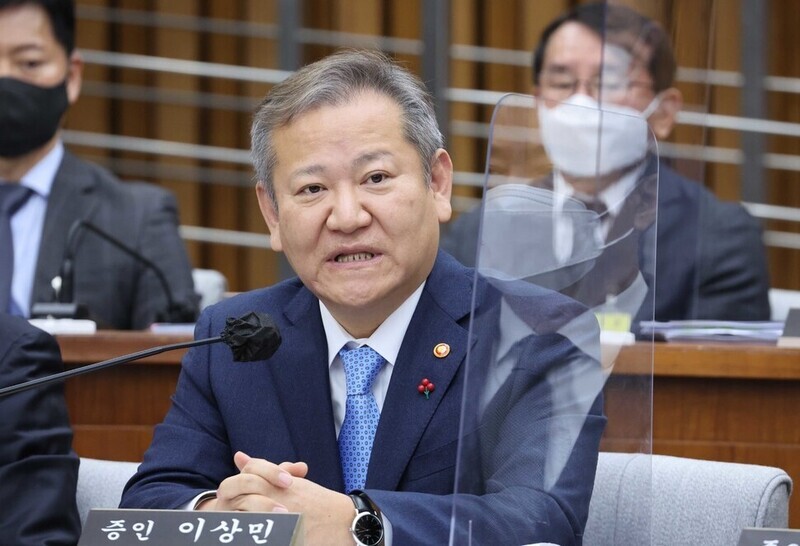hankyoreh
Links to other country sites 다른 나라 사이트 링크
[Guest essay] 2 things the Ministry of Interior and Safety should have done in Itaewon, but didn’t


“This was a new kind of disaster that would have been hard to predict.”
“Setting up a central response headquarters wasn’t an urgent matter.”
“Under the law, the head of the emergency response team is supposed to be in charge of the scene [of the disaster].”
All those remarks were made by South Korean Interior and Safety Minister Lee Sang-min during the National Assembly probe aimed at preventing a recurrence of the deadly crowd crush that happened in the Seoul neighborhood of Itaewon last year.
These remarks by the national head of disaster and safety management raised questions about whether the Interior and “Safety” Ministry (MOIS) actually bore no responsibility for the tragedy.
But it does bear responsibility: there were two things it ought to have done, but failed to do.
First, the ministry didn’t prepare in advance for disasters that can occur in densely packed crowds. The Itaewon crowd crush was by no means a “new kind of disaster.”
There has been an ongoing series of fatal crowd crushes, including the Seoul Station accident in 1960, the Hillsborough disaster in 1989, the Akashi pedestrian bridge accident in 2001, and the Sangju Concert accident in 2005, to name a few.
Every Halloween, huge crowds of people arrive in Itaewon. Last year, the area was expected to be more packed than ever because social distancing rules that had been in place due to the pandemic had been lifted.
Considering that the MOIS was advised to improve the legal regime and policy guidelines based on an analysis of crowd crushes in Korea and overseas in November 2017, why didn’t it take steps to prevent a disaster in advance? That’s a question that merits further investigation.
Second, it did not play its part in overseeing response duties after the disaster occurred. The Framework Act on the Management of Disasters and Safety states that emergency rescue efforts during a disaster are the responsibility of the fire department (emergency rescue control group), with central administrative agencies supervising “response and recovery” efforts as a “disaster management agency.”
In the parliamentary audit, Lee Sang-min testified that he had “designated the MOIS as a disaster management agency immediately after the disaster.”
If this was the case, he should have “controlled” disaster response duties by promptly establishing a central disaster management headquarters or central countermeasure headquarters for general management of the disaster situation, coordination/control for a swift recovery, examination of the emergency rescue and emergency activity situation, examination of support areas, identification of the victims, and situation management.
But in an Oct. 30 document titled “Central Countermeasure Headquarters Response Situation for the Accident in Itaewon, Yongsan District,” the only major MOIS actions listed were a “visit to the scene by the Minister of the Interior Safety” at 1:05 am that day and the “launch of a central countermeasure headquarters” at 2:30 the same morning.
This indicates that the central countermeasure headquarters was launched four hours and 15 minutes after the tragedy, with no practical measures taken.
This contrasts with the situation when an earthquake occurred in Goesan County, North Chungcheong Province, at 8:27 am the same day on Oct. 29. At that time, the MOIS immediately launched a central countermeasure headquarters and held a situation assessment meeting to adopt response measures.
The lack of proper oversight and direction of disaster response duties resulted in problems with a shortage of firefighters performing emergency rescue efforts at the scene of the Itaewon tragedy, along with delays in the dispatching of police for control activities. This only exacerbated the losses, with no effective management as the dead and injured were sent off to different locations.
That explains the need for additional investigation of the circumstances surrounding the disaster management agency designation and the MOIS’s subsequent response.
Another area that needs to be investigated is the delay in the central disaster and safety situation room’s reporting of the situation and the inadequacy of the early measures taken. Lee received a report an hour after the tragedy occurred, while the president’s orders were conveyed to the respective agencies 50 minutes later.
Yet another is the inadequate construction and operation of the disaster safety communication network. No such network was created and connected with the firefighters’ communication network or used during the tragedy.
Additional areas to investigate include the appropriateness of Lee’s belated visit to and orders at the scene, as well as what the MOIS disaster and safety management headquarters director, central disaster and safety situation room director, disaster cooperation office director, or social disaster response policy officer were doing after the tragedy occurred.
The ultimate purpose of investigating a societal tragedy is to create a safe society by preventing disasters from happening in the first place, or by preventing similar disasters to ones that have occurred.
According to the Framework Act on the Management of Disasters and Safety, the roles and duties are divided so as to minimize losses, as various institutions involved in disaster-related efforts — including firefighters, police, and local governments — take on overlapping or competing functions in disaster prevention and response.
The starting point for an investigation should be determining precisely what role each institution plays in the disaster prevention and response system and why they did not operate appropriately this time.
This is why it is so essential to review not only the emergency response on the ground but also the matter of disaster response oversight.
The police special investigation headquarters that probed the Itaewon tragedy decided not to file an accusation against Lee Sang-min. Even in the case of the parliamentary audit, the investigation of the MOIS was only one part.
The MOIS said that it is not conducting any separate investigation into the cause of the disaster. This means there has not been any clear investigation into how Lee or other officials went about their disaster and safety management duties.
An investigation of the MOIS and determination of responsibility are essential to uncover the truth of the Itaewon crowd crush and prevent similar incidents from happening again.
Please direct questions or comments to [english@hani.co.kr]

Editorial・opinion
![[Column] Is Korean democracy really regressing? [Column] Is Korean democracy really regressing?](https://flexible.img.hani.co.kr/flexible/normal/500/300/imgdb/original/2024/0705/2917201664129137.jpg) [Column] Is Korean democracy really regressing?
[Column] Is Korean democracy really regressing?![[Column] How tragedy pervades weak links in Korean labor [Column] How tragedy pervades weak links in Korean labor](https://flexible.img.hani.co.kr/flexible/normal/500/300/imgdb/original/2024/0703/8717199957128458.jpg) [Column] How tragedy pervades weak links in Korean labor
[Column] How tragedy pervades weak links in Korean labor- [Column] How opposing war became a far-right policy
- [Editorial] Korea needs to adjust diplomatic course in preparation for a Trump comeback
- [Editorial] Silence won’t save Yoon
- [Column] The miscalculations that started the Korean War mustn’t be repeated
- [Correspondent’s column] China-Europe relations tested once more by EV war
- [Correspondent’s column] Who really created the new ‘axis of evil’?
- [Editorial] Exploiting foreign domestic workers won’t solve Korea’s birth rate problem
- [Column] Kim and Putin’s new world order
Most viewed articles
- 110 days of torture: Korean mental patient’s restraints only removed after death
- 2[Column] Is Korean democracy really regressing?
- 3Real-life heroes of “A Taxi Driver” pass away without having reunited
- 4Former bodyguard’s dark tale of marriage to Samsung royalty
- 5What will a super-weak yen mean for the Korean economy?
- 6[Reportage] Inside some of Korea’s 1,067 small towns facing extinction
- 7Koreans are getting taller, but half of Korean men are now considered obese
- 8[Photo] Twitter now lets users decide who can reply to their tweets
- 9Democrats seek to impeach 4 prosecutors, including those tied to probes into Lee Jae-myung
- 10Beleaguered economy could stymie Japan’s efforts to buoy the yen